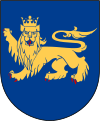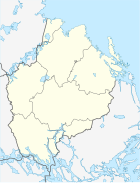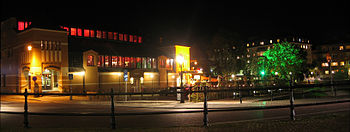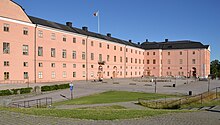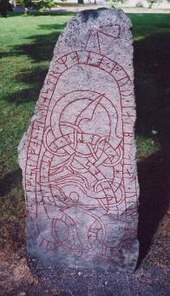Uppsala
| Uppsala | ||||
|
||||
| State : | Sweden | |||
| Province (län): | Uppsala län | |||
| Historical Province (landskap): | Uppland | |||
| Municipality : | Uppsala | |||
| Coordinates : | 59 ° 52 ' N , 17 ° 38' E | |||
| SCB code : | 0656 | |||
| Status: | Crime scene | |||
| Residents : | 149,245 (December 31, 2015) | |||
| Area : | 43.74 km² | |||
| Population density : | 3412 inhabitants / km² | |||
| Height : | 15 m ö.h. | |||
| Telephone code : | (+46) 18 | |||
| Postal code : | 750 02 - 759 00 | |||
| List of perpetrators in Uppsala County | ||||
Uppsala [ ˈɵpːˌsɑːla ] , also obsolete Upsala , is a city in the Swedish province of Uppsala län and the historic province of Uppland . Uppsala is the capital of the province and capital of the municipality of the same name .
In terms of population, the city is the fourth largest city in the country after Stockholm , Gothenburg and Malmö and is divided into seven districts .
Uppsala is a traditional and well-known university city . The University of Uppsala was founded in 1477 and is therefore the second oldest university in Scandinavia after the Studium generale of 1425 in Lund , Denmark . The city is the seat of the Archbishop and the Bishop of the Uppsala Diocese of the Church of Sweden .
geography
Uppsala is located about 72 km north of Stockholm and about 37 km from Arlanda Airport. The river Fyrisån runs through the village and flows into Lake Mälaren 8 km further south . Uppsala lies partly at the foot of a scree ridge and partly on top of it, which is called Uppsalaåsen , dates back to the last ice age and extends over 500 km from Härjedalen to the south of Stockholm to the Södertörn peninsula .
history
Beginnings to the 13th century
The place where Uppsala is today was originally called Aros and later Östra Aros, so as not to be confused with Västra Aros, today's Västerås . The name Aros means estuary and is made up of the old Swedish genitive form of a for river and os for mouth. He was referring to the confluence of the Fyrisån in the fjord , which was connected to the Baltic Sea during the Viking Age . The fjord was slowly drained by the land uplift and the increasing siltation. Early traditions mention a port at this estuary. Travelers moored their boats here in order to travel further by land to Uppsala, five kilometers away, today's Gamla Uppsala ("Old Uppsala"). The Söderby hoard dates from this early period .
When the local pagan center with the presumed temple of Uppsala no longer existed, the importance of the city as the most important Ting and market place as well as royal seat declined and Christianity prevailed in Uppland , Old Uppsala became the bishopric. However, Östra Aros remained an important port for trade in Uppland but also as far as Norrland . At the beginning of the 13th century, Alt-Uppsala had lost so much of its importance that in the years 1215/16 there were already initial considerations to move the archbishopric and the cathedral church to Sigtuna , which had been the bishopric since the 12th century. However, the considerations were not put into practice, but only continued around 1240, when a cathedral chapter was established. Finally, Pope Alexander IV granted permission to move to Östra Aros in 1258 on the condition that the cathedral should keep its name.
Whether the church of St. Per already existed in what is now Uppsala at this point in time has not been proven, as it was first mentioned in writing in a will in 1302. In contrast, the Trinity Church (Helga Trefaldighets kyrka) - first mentioned in 1221 - was already on the west side of the river and the Church of Our Lady (Vårfrukyrkan) a little further south of St. Per on the east side of the river. The Dreifaltigkeitskirche was already the meeting place for the rural community there. Otherwise, the western side was rather sparsely developed when the bishopric moved in 1273. Shortly afterwards, the name Uppsala began to be used instead of Östra Aros. After the move, not only the servants of the church ensured an upswing, but also pilgrims and other travelers who came to the major church festivals.
14./15. century
During the Middle Ages , but also at the time of Magnus Ladulås , German craftsmen and merchants settled in Uppsala. Legally, the city differed from the surrounding area in that it was granted city rights before 1302 . This year, a Vogt and a city council reported for the first time . Reports also date from the same period that the city was at least partially surrounded by a moat and that the two previously named churches, St. Pers's Church and Heliga Trefaldighets Church, certainly existed.
The royal domain "Islandet" (Swedish. Kungsgården "Islandet" ) was first mentioned in 1338. It served primarily as the residence of the bailiff, but was also used as the residence of the king when he was in Uppsala. Duke Karl lived there in 1594 before handing the property over to the governor Kristofer Wärnstedt in 1610. The former bishopric was located on the site where the university is today and was built around 1340. The school belonging to the cathedral was on an island in Fyrisån, Studentholmen (Swedish student island ). In 1477 Archbishop Jakob Ulfsson obtained the Pope's permission to set up a “studium generale”, ie a university. It is the second, and oldest still existing, university in Scandinavia and was initially located in the rooms of the cathedral school.
In the Middle Ages it was the property of a bishopric that shaped Uppsala's development. As a coronation place and place for important meetings (Swedish herredagar ) it was also seen as the actual capital of Sweden during this time. During the time of the Kalmar Union , the city was the scene of several disputes. During the clashes in 1470 the cathedral church was stormed and in 1501 the royal domain was burned down. In addition, Uppsala has been reduced to rubble by fires on several occasions. The most devastating fire occurred in 1473 when the cathedral church and several large buildings were damaged.
16.-18. century
During the war of liberation under Gustav I. Wasa , the bishopric was set on fire in 1521. The situation changed as a result of the Reformation and the Church's loss of influence. The two aforementioned churches slowly fell into disrepair. The monastery and most of the other ecclesiastical properties were confiscated from the Crown. The affiliated school was completely closed. As a result of this and the elimination of the generous orders from the Church, there was an economic decline. The population decreased. However, the king held on to Uppsala and regularly visited the city and his court, so that the decline was cushioned. With the start of construction on Uppsala Castle in 1547, the economic situation began to improve again. Construction drew large numbers of workers to the city, and the hope of a permanent royal residence made Uppsala a magnet.
The economic recovery continued in the times of Erik XIV and Johan III. away. The latter, however, moved the university, which was almost closed, to Stockholm. However, the relocation had little impact on the city's development. Uppsala was hit harder by the fire of 1572, but Johan III. tried to ensure that the city recovered quickly. It was still the place of coronation and the place of large meetings (Swedish herredagar ). The most important meeting took place in 1593 as the Synod of Uppsala ( Uppsala möte ), when the church conditions were reorganized and the city got its university back. Since the college in Stockholm was no longer continued, there was no longer any competition between the two cities. Thanks to gifts from Gustav II Adolf , the university was provided with sufficient financial resources and was able to ensure its continued existence. In the Middle Ages the church was the motor for the development of Uppsala, now the university should take on this role.
In the 17th century, Olof Rudbeck d. Ä. the good development of Uppsala. He worked to ensure that the university could develop to its best in a good environment. Its mission was thrown back by a great fire that broke out on the night of May 15-16, 1702. The fire devastated most of the city. The cathedral, the castle and most of the university buildings with the exception of the Gustavianum were damaged. Not only was the material damage enormous, cultural values also fell victim to the flames. It took decades for the city to recover.
19th century to the present
When the city slowly recovered, the Kungsängen district and part of Fjärdingen were devastated again in 1766. The undestroyed part of Fjärdingen went up in flames in 1809. After moderate growth in the period that followed, things only picked up with the inauguration of the railway line from Stockholm to Uppsala. By moving the artillery regiment from Uppland to Uppsala, the city received further growth impulses, so that in 1888 it had 21,249 inhabitants.
The spelling of the city name was changed from Upsala to Uppsala around 1903 .
Attractions
Uppsala is one of Sweden's main tourist attractions.
Uppsala has a cathedral (built 1289-1435, destroyed in a fire in 1702 and rebuilt, largest church in Scandinavia), a castle (planned in 1540, residence in 1757) high above the city, the famous Carolina Rediviva university library with the Codex Argenteus and the Carta Marina , a university auditorium and the Gustavianum University Museum with the anatomical theater . The Coin Cabinet of Uppsala University is also of international importance .
The city has a pronounced student life around the nations , student houses, which, arranged according to Swedish landscapes, have taken on many tasks that the student unions in Germany perform. These are also available in this form in Lund and in the younger university towns.
Also worth seeing are the botanical garden from the 18th century on the back of the castle, the garden of Linné , a Viking museum, the royal tombs of Gamla Uppsala (Old Uppsala) and the manor Linnés Hammarby , which is a few kilometers southeast of the city.
A curiosity is the photo - gallery London in the underground premises of a former restroom along the lines of London Underground .
See also: Fiby urskog
Culture
Valborg
Valborg or sista April (also Valborgsmässoafton ), Walpurgis Night , is celebrated by students and professors in all Swedish university towns on April 30th.
The day starts at 7 a.m. with a champagne breakfast , after which you go to Forsränningen at 10 a.m. , where students go down Fyrisån with their self-made rafts. Then you sit down in a park or meet on Slottsbacken , the hill by the castle, to have the traditional Sillunch . This consists of pickled herrings (sill) and other delicacies such as strawberries .
Then you go to Carolina Rediviva , where at 3 p.m. the rector of the university waves from the balcony with his student cap to greet spring, and the students wave back (mösspåtagning) . Then all the students present run down the mountain to the " Nations " to celebrate.
Sports
Uppsala is a center for bandy (a type of ice hockey). Five clubs in the city have a department for this sport ( IFK Uppsala , IK Sirius , IF Vesta , IF Vindhemspojkarna and Uppsala BOIS ). In addition, the final of the Swedish Bandy Championship is held annually in March on the grounds of Studenternas idrottsplats .
It is also noteworthy that the oldest swimming club in the world, which is also the oldest Swedish sports club, was founded in Uppsala. In the same sports hall complex, clubs train in basketball , weightlifting , volleyball , fencing and floorball . The last-mentioned sport is a crowd puller alongside bandy.
One of the city's clubs is Uppsala Studenters IF , whose handball division became Swedish champions in 1939.
language
Among artisans and traders you can still find an Uppland dialect that is similar to the Stockholm dialect. However, the number of people who speak this dialect is steadily decreasing, and Standard Swedish with a Norrland influence is being spoken more frequently in its place. This change was mainly caused by the large number of students and newcomers to Norrland .
music
There is a very modern concert and congress hall in Uppsala. The many choirs are striking , e.g. B. Orphei Drängar or OD ("Orpheus' Knechte"), since 2008 directed by Cecilia Rydinger Alin . There are also other groups that play all styles of music from jazz to punk . The Katalin Music Pub , where jazz and blues are played, is located just behind the main train station. It is located in a brick building from the end of the 19th century that used to be a warehouse for the railway. When it comes to rock music, the city has produced some groups that are well known all over Europe. Many of the student nations hold concerts on a regular basis, but access is limited to those with a student or guest ID card. The Uppsala Reggae Festival took place in Uppsala until 2011, but in 2012 it was relocated to Furuvik 10 km south of Gävle as the FRF Furuvik Reggae Festival .
Movie
The Uppsala International Short Film Festival has been taking place in Uppsala since 1982, one of the most important short film festivals in Europe. The Slottsbiograph is one of the oldest city cinemas.
Healthcare
Uppsala is that of Marie Lindquist led Uppsala Monitoring Center (UMC), a body of WHO for pharmacovigilance .
traffic
automobile
The most important roads in Uppsala are the European route 4 and the state roads ( Riksväg ) 55 and 72. The European route was completed as a motorway in October 2007, so that there is a continuous motorway connection between Stockholm and Gävle. In the urban area of Uppsala, the old route of the E 4 is a wide thoroughfare with a median and a guard rail. Crossings with other streets are equipped with traffic lights or take the form of a roundabout . Many commuters travel to Stockholm or Arlanda Airport every day.
railroad
Uppsala is on the Ostkustbana , a main route with a dense train sequence. The Mora – Uppsala railway , also known as Dalabanan , branches off to Borlänge and Mora north of the main train station . The reconstruction of the 1979 line to Enköping is currently being discussed.
From 2005 to December 2011, Uppsala Central Station was rebuilt and expanded. Since then, the listed old station building from 1866 has no longer been used for railway purposes; there is now a restaurant and a jazz bar. In the course of the renovation work, the former level access to the platforms, secured by barriers, was removed and replaced by an underpass.
There is very heavy train traffic in the direction of Stockholm and Stockholm / Arlanda Airport . During the day, two shuttle trains operated by Storstockholms Lokaltrafik (SL) run every hour via Arlanda to Stockholm's central station (55 minutes). There is also at least one regional train operated by SJ AB (SJ) directly to Stockholm's central station (38 minutes), as well as long-distance trains from SJ and other private railway companies. Trains also run regularly to Sundsvall and Östersund, as well as to the Dalarna region .
plane
Since Arlanda Airport is closer to Uppsala than Stockholm, it can just as easily be considered Uppsala Airport. In addition to the aforementioned rail connection, there is also a dense bus service to the airport. The Arna military airfield , which is currently still in use by the Air Force, is located directly north of the city . The possibility of using the Uppsala-Ärna military airfield for civil air traffic was discussed for a long time without a conclusion. In June 2018, these plans were filed.
economy
In addition to the university and the public sector, the city's economy is dominated by biomedical and pharmaceutical companies. The largest of these is Fresenius Kabi (formerly: GE Healthcare or Pharmacia ); but there are also a large number of small and medium-sized companies in this economic sector. All are closely linked to the University's Biomedical Center (BMC).
The authorities for pharmaceuticals, food, veterinary medicine and geological investigations are located here at state institutions . Uppsala is also very important as a place of residence for the approximately 16,000 commuters who travel to work in the greater Stockholm area every day. The Uppsala Monitoring Center, supported by the World Health Organization and the Swedish government, for the worldwide recording of adverse drug reactions, is of particular importance for drug safety .
There used to be several units of the military in Uppsala, e.g. B. an infantry regiment (I 8), a telecommunications regiment (S 1) and two air force units (F 16 and F 20) and the Army NCO school. Today there is only the Tactical Aviation School (LSS) and the Center for Intelligence Service (FM UndSäkC) in the area around Ärna Airport.
Town twinning
since 1947:
- Bærum in Norway
- Frederiksberg in Denmark
- Hafnarfjörður in Iceland
- Hämeenlinna in Finland
since 1988:
- Tartu in Estonia
since 2000:
- Minneapolis in the USA
Personalities
Others
In 1969, Kirsti Sparboe was in the German charts for 14 weeks with her title A Student from Uppsala .
See also
literature
- Torgny Nevéus, Nanna Cnattingius (Red.): Uppsala stads historia. 7, Från Östra Aros till Uppsala: en samling uppsatser kring det medeltida Uppsala . Almqvist & Wiksell, Uppsala 1986, ISBN 91-970486-5-8 .
Web links
- Official website of the municipality (Swedish)
- Official website (English)
- Uppsala Tourism - Tourist website of the city of Uppsala (English, Swedish)
Individual evidence
- ↑ a b Statistiska centralbyrån : Land area per Tatort, folkmängd and invånare per square kilometer. Vart femte år 1960 - 2015 (database query)
- ↑ Document report till Översiktsplan för Uppsala commun. (PDF (16 MB)) Uppsala kommun, accessed on December 23, 2015 (Swedish).
- ↑ unt.se Uppsala Nya Tidning: Planerna på civilt flyg på Ärna skrotas , June 8, 2018 (Swedish), accessed on April 4, 2020
- ^ Uppsala Monitoring Center
- ↑ Sten Bernhardsson: Report om vänortsmöte i Fredriksberg 25–30 May 2015. (PDF; 3.47 MB) In: uppsala.se. August 31, 2015, p. 1 , accessed August 16, 2016 (Swedish).
